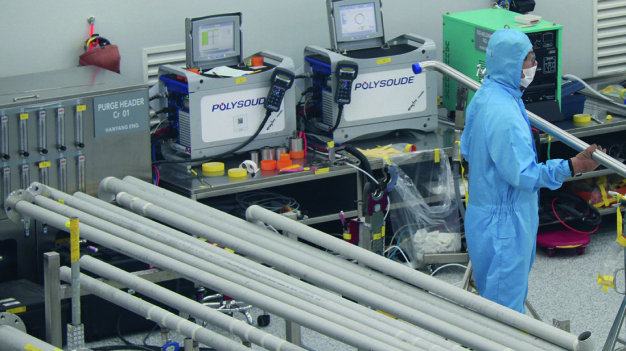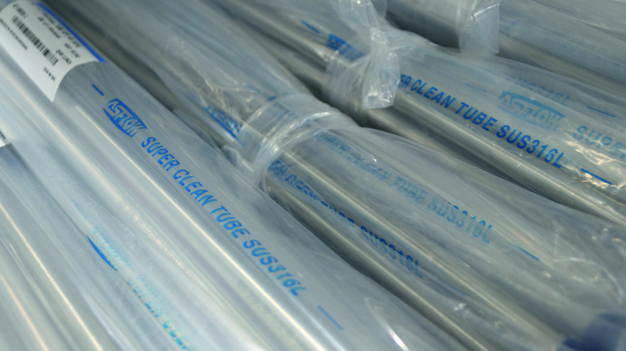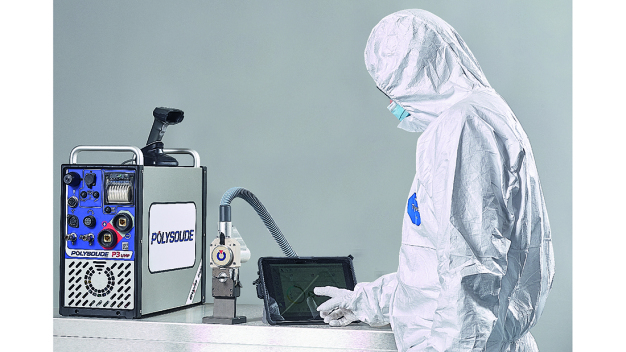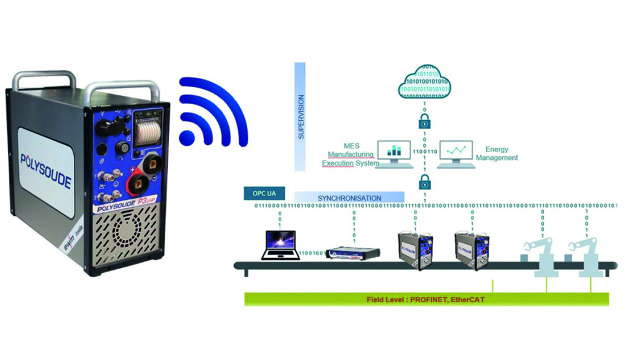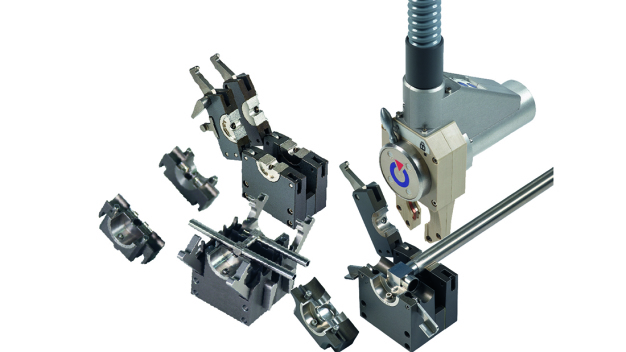Dr.-Ing. Jürgen Krüger
TIG welding in the Ultra High Purity (UHP) industry
Whenever high-quality joints are required, GTAW (Gas Tungsten Arc Welding) or TIG (Tungsten Inert Gas) welding, as it is commonly called, will offer a perfect solution.
A wide range of products has to be manufactured under white room or clean room conditions. These products may be susceptible to microbes, as it is the case with pharmaceutical ingredients, to contaminations, as seen in the field of micro-electronics, and to foreign objects, which have to be kept out of optical devices and precision mechanics.
In many cases the components for the equipment which is intended to be operated inside of clean rooms have to be produced and assembled under controlled atmosphere as well. Tube network e.g. is frequently used to supply clean room installations with ultra-pure gases and liquids, which serve for inertisation, etching, rinsing, diluting and injection purposes.
In order to minimize the effort on site, as many as possible of the connections for the tube network installation of a clean room supply are pre-fabricated. In the factory; standard pieces like micro-fittings, Tees, elbows and valves are welded together with matching tube segments. Here, the use of orbital TIG welding can provide significant advantages. Complete weld cycles are carried out automatically and lead to consistent high quality results.
White or clean rooms are specifically designed for the requirements of a particular sector of activity. Composition, temperature and humidity of the controlled atmosphere are regulated by precise specifications, but the most important limits concern the size and number of airborne particles. Depending on the highest permitted particle concentration the standards ISO 14644-1 and FED STD 209E divide clean rooms in different classes: Iso Klasse 1 and FED class 1 stand for the lowest particle concentration, whereas Iso Klasse 9 and FED class 100,000 are equivalent to unfiltered room air.
To keep the contamination inside a clean room as low as possible, any generation or emission of particles has to be avoided.
Sending out an average stream of 100,000 particles per minute with a size of less than 50 µm the human body is considered as one of the most important particle sources in a clean environment, especially in case of fast movements. Thus, workers or visitors in a clean room have to wear specific cloths: the head and hair are covered by a cap, the face including eyes, nose and mouth is completely enclosed by a protective mask with goggles, the hands are gloved, galoshes fit over standard footwear and the rest of the body is wrapped in an appropriate lab coat or working suit, standard footwear and the rest of the body is wrapped in an appropriate lab coat or working suit.
Manufacturing processes can also be the origin of significant particle emissions. Each electric arc which is struck during a TIG welding procedure is accompanied by clouds of vaporising metal and streams of welding and backing gas. Additionally, the released heat provokes turbulences between inert gas and surrounding air and entrains undesired pollutants.
However, the adverse side-effects of an open arc can be avoided. Closed orbital welding heads have initially been invented as fast and efficient tool for the numerous butt weld connections of airplane hydraulics. Ease of use, productivity and outstanding weld quality had been the targets of the development, finally all of them are met by full. Later on, the advantages of an arc burning inside a closed chamber had been exploited for clean room purposes. Hot surfaces, turbulences, radiation, uncontrollable particle emission – the entire inconveniences provoked by an open electric discharge could be eliminated. Today, closed orbital TIG welding heads have become indispensable tools whenever tubes and accessories have to be welded together under clean room conditions.
With regard to the best possible benefits and a wide range of applications the welding equipment should be developed and designed especially for the various clean room requirements.
A smart welding station should be able to supply and control the entire range of closed orbital welding heads for micro-fittings and important tube diameters. Due to its very low weight it can be moved by the operator without any hoisting equipment, which is important to keep the clean room clean. The operating elements should be independent from the power source, so the device can be kept somewhere outside the work bench. If a liquid cooling circuit becomes necessary for bigger tube diameters or improved productivity, the cooling device should be independent from the power source.
To meet the upcoming challenges of Industry 4.0, the recent findings about digitalisation, connectivity, communication and traceability should have been taken into account. This applies both to the data exchange between the different components of the equipment and the internal network of the factory. In this context the OPC-UA protocol delivers the perfect interface to the Industry 4.0 process.
The operator who works in a clean room environment has to face a lot of restrictions. Fast movements are forbidden, his visual field is obstructed by a mask and his tactile sense reduced by gloved hands. A professional welder checks the conditions of his equipment at a glance before he starts a weld cycle. If working under controlled atmosphere, this should be as easy as possible for the operator. With a barcode scanner, which may be used plugged or unplugged, he can read the QR-code on his working suit to introduce himself, in the same manner he can identify welding head, welding gas and workpiece. The matching welding programme is then proposed on his tablet, necessary inputs can be done even if wearing gloves.
Preparing of the weld is divided into two parts: fixing of the workpiece in the clamping unit, where it is possible to use clamping devices of other companies as well, and final positioning of the welding head including motor, gear, supply hose etc.
The real-time progress of the weld cycle can be watched on the tablet, where the momentary welding parameter values are displayed as well. These data are transmitted to the factory network at the same time. Finally, after a visual inspection of the completed weld, the operator can confirm the successful production of the joint.
POLYSOUDE S.A.S.
44300 Nantes
France





